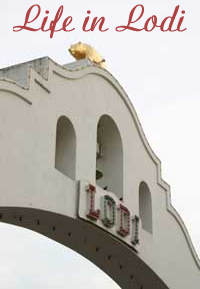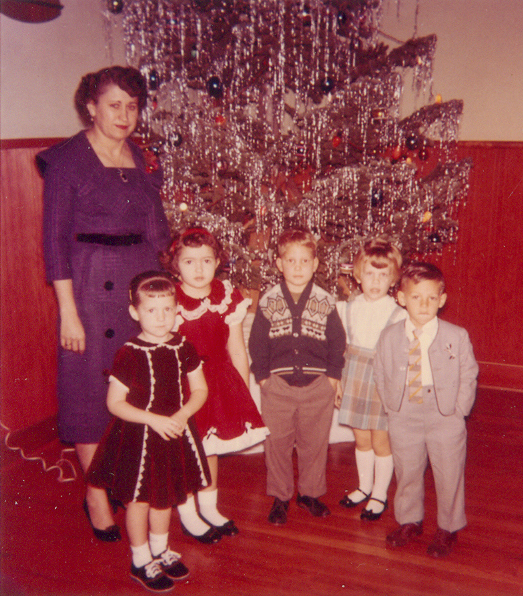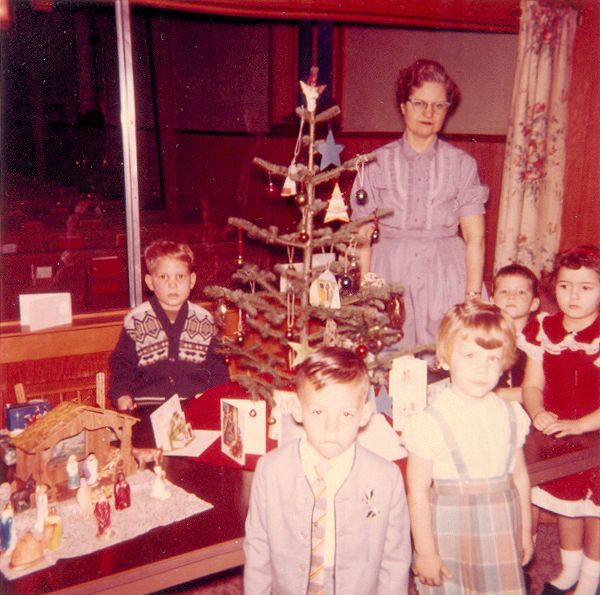 “The loss of a place isn’t really so different from the loss of a person. Both disappear without permission, leaving the self diminished, in need of testimony and evidence.” (Bridge of Sighs by Richard Russo)
“The loss of a place isn’t really so different from the loss of a person. Both disappear without permission, leaving the self diminished, in need of testimony and evidence.” (Bridge of Sighs by Richard Russo)
Becca Rowan challenged readers to “write about a place you’ve lost . . .” Her words invaded my consciousness last night.

Bacon, eggs, lefse, and coffee. Christmas morning breakfast was delicious. The fire is roaring, the tree is lit, and the boys will finish opening their presents in a little while. One is still sleeping because he stayed up very late with me last night. Among other things, we watched “Mamma Mia!” The other is enthralled with his new Wii games.
 I spent a little time this morning looking at photographs taken on Christmases past. Most of the people in the photos were wearing their finest clothing, the styles of which, along with the heights of the children, the various trees, and furniture seen in the background reveal the decade in which those moments were frozen forever. And most of the photos were taken in this very room while a fire crackled in the same fireplace, its smoke billowing out of the same chimney and wafting over the roofs of the same neighboring houses, most of which are owned by the same people who owned them throughout the decades in which those photos were snapped.
I spent a little time this morning looking at photographs taken on Christmases past. Most of the people in the photos were wearing their finest clothing, the styles of which, along with the heights of the children, the various trees, and furniture seen in the background reveal the decade in which those moments were frozen forever. And most of the photos were taken in this very room while a fire crackled in the same fireplace, its smoke billowing out of the same chimney and wafting over the roofs of the same neighboring houses, most of which are owned by the same people who owned them throughout the decades in which those photos were snapped.
On days like this, I am acutely aware of the degree to which continuity has been an overriding theme in my life.
There are other photos, too, including two that I found myself studying this morning with interest. The first was taken in the old sanctuary of the church in which I grew up on Christmas Eve 1960. That’s a four-year-old me in the red velvet dress my mother sewed for me, posing with my fellow members of the nursery Sunday School class and the teacher’s assistant, “Mrs. Verna Klipfel,” as her name is noted on the back of the photo. Her daughter is standing to my right.
The second photo was taken in our Sunday School classroom — the nursery that was situated behind the sanctuary. There were speakers mounted on the wall and the large window allowed parents to remove their fussy children from the worship service without having to miss it themselves. Through the window, you can see the old wooden pews with their hymnal racks on the back. In this photo, we are gathered around a Charlie Brown-esque tree with our teacher, Mrs. Frieda Williams.
Through the window, you can see the old wooden pews with their hymnal racks on the back. In this photo, we are gathered around a Charlie Brown-esque tree with our teacher, Mrs. Frieda Williams.
Both photos were taken before the annual Sunday School Christmas Program which always took place on Christmas Eve. At the conclusion of the program, we were given Life Saver books by the Sunday School Superintendent before heading home to open our presents.
When I was growing up in Lodi, it was a city known for its lack of diversity — of thought, as well as the heritage of its citizens. The photos you see in these photos accurately represent the racial composition of the congregation in those days.
I was not baptized in that church. That event took place in South Dakota when I was just three months old. But I grew up there. I earned a lapel pin for “perfect” Sunday School attendance ten years running, participated in all of the youth programs, was a fixture in the choirs, and began serving as a pianist at the age of eleven. I was confirmed and married BigBob there. My children were baptized and my father’s memorial service was conducted in the sanctuary that was remodeled in 1978. For many years, I was a part-time staff member, serving as choir accompanist, handbell director, and organist. From my piano or organ bench, I watched numerous couples say “I do” and countless family members dab tears while gazing at a casket parked in the same spot at the front of the sanctuary where brides and grooms stand after traversing the same center aisle.
Turmoil and upheaval befell the congregation in the mid 1990’s and continued well into this decade. A few pastors came and went, as did a significant number of long-time members, including me. In early 1998, following one conversation with the incoming pastor before he even stepped into the pulpit for the first time, I knew that my affiliation with the church had come to an end. It was traumatic, but I was convicted by the jarring realization that I could neither serve nor worship under that individual’s leadership.
Eventually, we joined another local congregation, primarily because I felt compelled to provide religious education to my children, but that church never felt like “home” — especially when the subject of civil rights was broached. That congregation could best be described as ultra conservative, mired in its own habits, traditions, and narrow world view. As a civil rights attorney, I frequently felt uncomfortable and embarrassed by the behaviors I observed and the words I heard spoken within those walls. And finally, with both children confirmed, as I had some nine years or so earlier vis a vis the church of my childhood, I felt compelled, as a matter of principled conviction, to distance myself from that place and the ideals espoused there. Since then, I’ve been very happily “unchurched.”
But the Christmas Eve candlelight service was always my favorite. I fondly recall spending weeks preparing to lead the congregation in singing the beloved carols. I also sang with and accompanied the choirs, performed with brass quartets specially hired for the occasion, and played a few solo pieces. For the past few years, the Christmas candlelight service has been the sole aspect of church worship that I have missed.
And as Christmas approached this year, I felt tugged back to my childhood congregation — the one I have always thought of as my “home” church — to once again experience the most magical, mysterious, and beautiful worship service of the church year.
But Thomas Wolfe insisted that You Can’t Go Home Again.
Continue reading here.


3 Comments
Gorgeous!
Mama Zen´s most recent post: Links
These are great pictures. You should have them laminated and mounted. They’re priceless. happy new year.
Jena Isle´s most recent post: A Metaphor? I’m Not Sure. Merry Christmas!
Any post that quotes both Richard Russo and Thomas Wolfe is one I know I’m gonna love. Can’t wait for Part 2!!
Shannon´s most recent post: Feast of the Holy Innocents- on Suffering